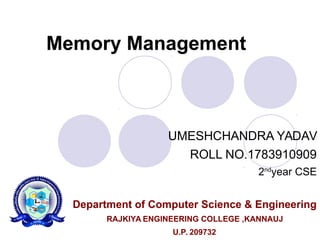
Memory management OS
- 1. Memory Management UMESHCHANDRA YADAV ROLL NO.1783910909 2nd year CSE Department of Computer Science & Engineering RAJKIYA ENGINEERING COLLEGE ,KANNAUJ U.P. 209732
- 2. CONTENT 1.INTRODUCTION 2.MEMORY REALLOCATION 3.MEMORY MANGEMENT UNIT 4.SAWPPING 5.PAGGING 6.FRAGMENTATION 7.SEGMENTATION
- 3. INTRODUCTION Memory management refers to management of main memory address. An Operating System activities for memory management 1.In multiprogramming, the OS decides which process will get memory when and how much. 2.Allocates memory when a process requests . 3.De-allocates memory when a process no longer needs it or has been terminated.
- 4. A pair of base and limit registers define the logical address space Base and Limit Registers
- 5. Multistep Processing of a User Program
- 6. Compile time Hardwire physical location at compile time(absolute code) Problem • Each program needs to be written with others in mind • Not really transparent Load time Compiled code relocatable (relocatable code) How? All addresses relative to a start address. Change start address to relocate Problem • Once loaded, can’t change or move Execution time Can move during execution This is what’s generally done, but need hardware support When to Relocate?
- 7. Logical address – generated by the CPU; also referred to as virtual address Physical address – address seen by the memory unit Logical and physical addresses are the same in compile-time and load-time address-binding schemes. Logical and physical addresses differ in execution- time address-binding scheme Logical vs. Physical Address Space
- 8. Contiguous Allocation Multiple-partition allocation Hole – block of available memory; holes of various size are scattered throughout memory When a process arrives, it is allocated memory from a hole large enough to accommodate it Operating system maintains information about: a) allocated partitions b) free partitions (hole) OS process 5 process 8 process 2 OS process 5 process 2 OS process 5 process 2 OS process 5 process 9 process 2 process 9 process 10
- 9. Dynamic Storage-Allocation Problem First-fit: Allocate the first hole that is big enough Best-fit: Allocate the smallest hole that is big enough; must search entire list, unless ordered by size Produces the smallest leftover hole Worst-fit: Allocate the largest hole; must also search entire list Produces the largest leftover hole How to satisfy a request of size n from a list of free holes
- 10. It’s hardware device that maps virtual to physical address In MMU scheme, the value in the relocation register is added to every address generated by a user process at the time it is sent to memory The user program deals with logical addresses; it never sees the real physical addresses Memory-Management Unit (MMU)
- 11. SWAPPING Swapping is a mechanism in which a process can be swapped temporarily out of main memory (or move) to secondary storage and make that memory available to other processes.
- 12. Paging Logical address space of a process can be noncontiguous; process is allocated physical memory whenever the latter is available Divide physical memory into fixed-sized blocks called frames (size is power of 2, between 512 bytes and 8,192 bytes) Divide logical memory into blocks of same size called pages
- 13. Paging Hardware
- 14. Fragmentation External Fragmentation – total memory space exists to satisfy a request, but it is not contiguous Internal Fragmentation – allocated memory may be slightly larger than requested memory; this size difference is memory internal to a partition, but not being used Reduce external fragmentation by compaction Compaction is possible only if relocation is dynamic, and is done at execution time
- 15. Segmentation Memory-management scheme that supports user view of memory A program is a collection of segments A segment is a logical unit such as: main program procedure function method object local variables, global variables common block stack symbol table arrays
- 16. Logical View of Segmentation 1 3 2 4 1 4 2 3 user space physical memory space
- 17. Segmentation Architecture Logical address consists of a two tuple: <segment-number, offset> Segment table – maps two-dimensional physical addresses; each table entry has: base – contains the starting physical address where the segments reside in memory limit – specifies the length of the segment Segment-table base register (STBR) points to the segment table’s location in memory Segment-table length register (STLR) indicates number of segments used by a program;
- 19. THANK YOU